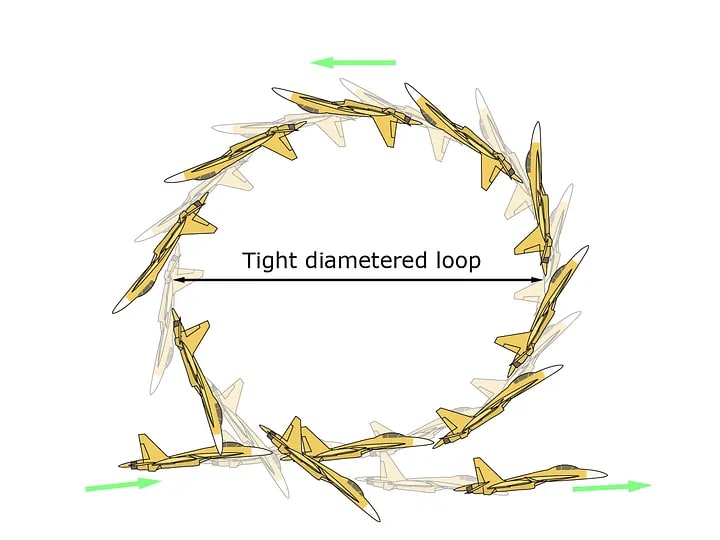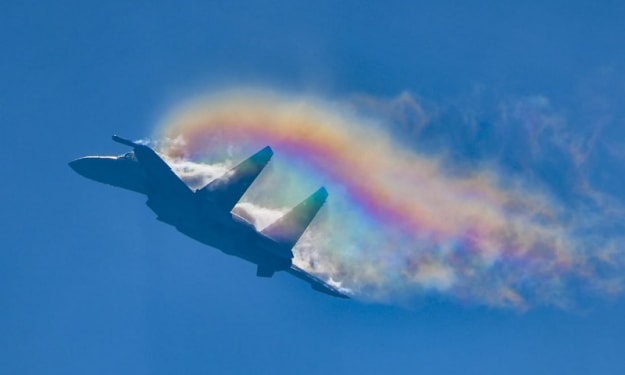The Kulbit Manoeuvre
No, it's not medical, although it could be vomit-inducing, even heart-stopping

If you love planes, as I do, then you might find this story interesting.
It was over ten years ago when I was researching a NATO/China aerial battle set in my novel ‘Gate of Tears’ that I first heard of the Kulbit. The ding-dong was then set in the future and involved UK F35s against Chinese J20s over the Red Sea (the aerial battle scenes in my book were vetted by an ex-Harrier pilot).
I’d been aware of ‘viffing’ — vectoring in flight — which was supposedly used by British Sea Harrier pilots in the 1982 Falkland war. However, that seems to be an urban myth.
Viffing
Viffing involved moving the Harrier’s thrust angle lever sharply forward during regular flight. The story goes that it was first tried when a US Marine Corps AV-8A Harrier went from 500 knots on the flat, to 200 knots in a sharp ascent, in the time it took the pilot to break his nose on the glareshield. He may have been the first to do it, but I think the guys who came later didn’t break their noses.
There was speculation that the manoeuvre could be used to loop round behind an enemy.
Another version is a simple nose up ‘dead stop’ manoeuvre, known as the Pugachev Cobra, but this could not be done by the Harrier.
Pugachev’s Cobra
In aerobatics, Pugachev’s Cobra (or Pugachev Cobra) is a dramatic and demanding manoeuvre in which an airplane flying at a moderate speed suddenly raises the nose momentarily to the vertical position and slightly beyond, before dropping it back to normal flight. It uses potent engine thrust to maintain approximately constant altitude through the entire move
The manoeuvre supposedly has some use in close range combat, and is an impressive trick to demonstrate aircraft’s pitch control authority, high angle of attack (AOA) stability and engine-versus-inlet compatibility, as well as the pilot’s skill. The manoeuvre is named after the Soviet test pilot Viktor Pugachev. — aircraft fandom
The Cobra does not however require super-manoeuvrability. It can be performed by non-thrust vectoring aircraft and still depends on the aircraft moving through air; it does not involve the aircraft’s aerodynamic/control surfaces and laminar airflow. It relies on the whole airframe as a solid shape traveling through the air.
The Cobra has been used several times in combat, for example by an Egyptian pilot in the Yom Kippur War: an Israeli pilot mentioned an Egyptian MiG-21 apparently standing on its tail while trying to evade an attack.
The Swedish SAAB Draken 35 (.gif):

Super-manoeuvrability
Supermaneuverability is the capability of fighter aircraft to execute tactical maneuvers that are not possible with purely aerodynamic techniques. Such maneuvers can involve controlled side-slipping or angles of attack beyond maximum lift — Wikipedia
In 1983 the Russian MiG-29T and Su-27 in 1986 had this ability, which has since become standard in all of Russia’s fourth and fifth generation aircraft. Commentators say that the precise mechanism behind the super-manoeuverability of Russian-built planes has not been made public.
The emphasis on close-range, slow-speed super-manoeuverability in Russian aircraft design is totally opposite to the Western energy–maneuverability theory (EM), based on conserving kinetic energy throughout an aerial battle to gain a more varied range of maneuvering possibilities during the engagement. The EM theory was developed by an eccentric US flying genius, John Boyd.
Nevertheless, the US developed the super-manoeuvrable F-22 Raptor.

But it’s the Kulbit that goes further than the Cobra, into a complete stall and back flip.
The Kulbit
In simple terms
The “Kulbit” is an aerial maneuver developed by Russian pilots in which the aircraft performs an extremely tight loop, often not much wider than the length of the aircraft itself. It differs from the traditional inside loop as it uses post-stall maneuvering capabilities, a type of supermaneuverability. — Wikipedia

In technical terms
The Kulbit is a variation on the Cobra maneuver but with a higher pitch rate and continuous positive pitch rate throughout the rotation. It requires two things:
- A docile pitch behavior of the airframe over the full angle of attack range of 360°. Docile means that the pitch moments stay low and do not change abruptly with the angle of attack.
- Thrust vectoring nozzles to keep the pitch rate up.
The control surfaces only play a minor role — they are only important initially to start the pitch-up motion which is done by negative elevator and/or positive canard deflection. (Technical explanation credit: stackexchange).
The Russians developed it. Now the US F-35 can do it:
The retired Harrier pilot who provide technical input to my book 'Gate of Tears' had not heard of the Kulbit in 2010. And that urban myth about viffing? Well, if it didn’t work for Harriers, then why was the Cobra (a very close cousin) being used in combat? I’m still puzzling over that.
And me?
Apart from travel the only flying I’ve done was a single lesson in a Piper Tomahawk, a birthday gift. Fabulous, but flying is an expensive pastime. In another life I’d have liked to have had a private pilot’s licence. But instead I do boats, and I have been known to vomit…
There are consolations though. I live on my boat. I can anchor for the night. And sleep.
In a Piper Tomahawk I’d be back on the ground within two hours — one way or another, and as they say, any landing you walk away from is a good landing.
And the name ‘Kulbit?
The name “Kulbit” is derived from the Russian Кульбит, meaning “somersault”. The alternate name, “Frolov’s Chakra”, refers to Russian test pilot Yevgeni Frolov, the pilot who first carried out the manoeuvre, while “chakra” is a yogic term, meaning “vortex” or “whirlpool”.
There you have it. Thanks Wikipedia.
There are old pilots, and there are bold pilots. But there are no old bold pilots.
I wonder if Yevgeni Frolov ever got to collect his pension?
***

Canonical link: This story was first published in Medium on 19 June 2022
About the Creator
James Marinero
I live on a boat and write as I sail slowly around the world. Follow me for a varied story diet: true stories, humor, tech, AI, travel, geopolitics and more. I also write techno thrillers, with six to my name. More of my stories on Medium






Comments
There are no comments for this story
Be the first to respond and start the conversation.